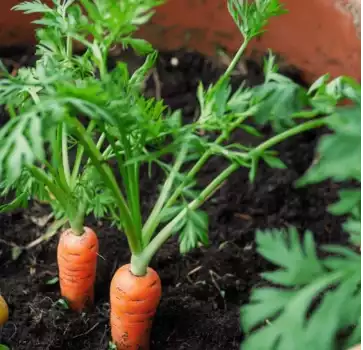Growing carrots from seed is a rewarding and straightforward gardening project that can provide a steady supply of this nutritious vegetable. Whether you’re a beginner or an experienced gardener, this guide will walk you through every step, from seed to harvest.

1. Why Grow Carrots at Home?
Carrots are versatile, easy to grow, and can thrive in a range of climates. Here’s why growing them at home is beneficial:
Benefits:
- Fresh, Flavorful Produce: Homegrown carrots have a sweeter and more robust flavor than store-bought varieties.
- Health Benefits: Carrots are rich in vitamins A and C, as well as antioxidants.
- Cost-Effective: Growing your own carrots can save money compared to purchasing them regularly.
2. Choosing the Right Carrot Varieties
Selecting the best carrot variety for your garden depends on your climate, soil type, and preferences. Different types of carrots offer unique flavors, colors, and growing requirements.
Recommended Varieties:
- Nantes: Great for cool and temperate climates with its sweet flavor.
- Imperator: Known for its long roots and commonly found in supermarkets.
- Danvers: Ideal for heavier soils with shorter, thicker roots.
Pro Tip: Consider your soil type and climate when selecting varieties to ensure optimal growth.
3. Preparing to Plant Carrot Seeds
Carrots require specific growing conditions to germinate and thrive. Preparing the soil and planting at the right time are crucial for success.
Timing and Soil Conditions:
- Timing: Plant seeds in early spring or late summer for a fall harvest, depending on your climate.
- Soil Preparation: Carrots prefer loose, well-drained soil with a pH between 6.0 and 6.8. Avoid compact or rocky soil, as this can cause misshapen roots.
Tips for Maximum Germination:
- Planting Depth: Sow seeds about ¼ inch deep and keep the soil consistently moist until germination.
- Spacing: Thin seedlings to about 2 inches apart once they emerge to allow room for growth.
Learn more about improving soil quality for vegetables here.
4. Growing Carrots in Cool Climates
Growing carrots in cooler climates can present challenges, but with the right techniques, you can extend your growing season and enjoy a successful crop.
Cool Climate Strategies:
- Row Covers: Use row covers to protect seedlings from frost and extend the growing season.
- Raised Beds: Raised beds help warm the soil faster in the spring, promoting faster germination.
Cool-Climate Varieties:
- Nantes: One of the best options for cooler regions due to its shorter growing season.
5. Growing Carrots in Warm Climates
Carrots can thrive in warm climates if given the right care. Hot weather can cause carrots to become bitter, but with these tips, you can prevent heat stress.
Warm Climate Tips:
- Mulching: Apply mulch around plants to keep the soil cool and moist.
- Shading: In particularly hot regions, provide some shade during the hottest parts of the day to prevent bolting.
Varieties for Warm Climates:
- Danvers: This variety is more heat-tolerant and grows well in a variety of soil conditions.
6. Growing Carrots in Containers
If you have limited space, growing carrots in containers is an excellent option. Choose the right container size and soil mix for healthy root development.
Container Gardening Tips:
- Container Size: Use deep containers (at least 12 inches) to allow for proper root growth.
- Soil: Fill containers with loose, well-draining potting soil to encourage straight roots.
- Watering: Keep the soil consistently moist but not waterlogged.

7. Watering and Fertilizing Carrots
Proper watering and fertilizing practices are essential for growing healthy, sweet carrots. Carrots require regular moisture and balanced nutrients to grow properly.
Watering Tips:
- Consistent Moisture: Water frequently to keep the soil moist but avoid overwatering to prevent root rot.
- Deep Watering: Water deeply to encourage roots to grow downwards.
Fertilizing Carrots:
- Low Nitrogen Fertilizers: Use a low-nitrogen fertilizer to avoid excessive leafy growth and focus energy on root development.
8. Thinning and Mulching Carrot Plants
Thinning seedlings is necessary to prevent overcrowding and allow roots to grow without competition. Mulching helps retain moisture and suppress weeds.
Thinning Tips:
- Thinning Seedlings: Thin to about 2-3 inches apart once the seedlings are about 2 inches tall. Be gentle to avoid disturbing neighboring plants.
Mulching for Moisture:
- Mulch Layer: Add a thin layer of organic mulch around the base of the plants to maintain soil moisture and regulate temperature.
9. Common Carrot Pests and Diseases
Carrots can be affected by pests and diseases, but with early detection and treatment, these problems can be managed.
Common Pests:
- Carrot Flies: Use row covers or companion planting to deter carrot flies.
- Aphids: Control aphids with insecticidal soap or neem oil.
Common Diseases:
- Root Rot: Avoid waterlogged soil by ensuring proper drainage and watering practices.
- Alternaria Leaf Blight: Prune infected leaves and avoid overhead watering to reduce the risk of fungal infections.
External Resource: For more information on maximizing carrot germination, check out this guide.
10. Harvesting and Storing Carrots
Knowing when and how to harvest your carrots is key to enjoying sweet, tender roots. Proper storage ensures they last through the season.
Harvesting Tips:
- Signs of Maturity: Carrots are ready to harvest when their tops have reached about 1 inch in diameter. You can gently pull one up to check for size.
- Harvesting Technique: Loosen the soil with a garden fork before gently pulling the carrots out to avoid breakage.
Storing Carrots:
- Short-Term Storage: Store freshly harvested carrots in the fridge, where they can last for several weeks.
- Long-Term Storage: Carrots can be stored in sand or sawdust in a cool, dry place for several months.
Frequently Asked Questions
Q: How long does it take for carrots to grow from seed?
A: Carrots typically take 60-80 days from seed to harvest, depending on the variety and growing conditions.
Q: Why are my carrots misshapen or forked?
A: Forked or misshapen carrots are usually the result of compact or rocky soil. Make sure the soil is loose and free of obstructions.
Q: Can carrots be grown indoors?
A: Yes, carrots can be grown indoors in containers as long as they receive enough sunlight and the container is deep enough for root development.
Conclusion
Growing carrots from seed to harvest is a rewarding experience that provides fresh, healthy vegetables for your kitchen. With the right preparation, care, and attention, you can enjoy a bountiful carrot harvest, whether you’re planting in cool, warm, or even container environments.


1 thought on “How to Grow Carrots: From Seed to Harvest”